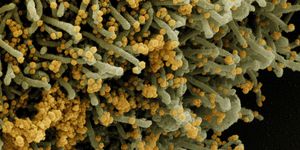A New Type of Cell Death is Discovered
Organisms from plants to fungi to animals also need copper for normal health. Copper is involved in several basic biological processes including the control of gene expression and the movement of some proteins. Copper is also known for its antibacterial properties; it discourages microbes from growing on its surface. Scientists have now learned more about why copper can kill cells; the metal seems to trigger a previously unknown form of cell death. This research, which has been reported in Science, has shown that copper can bind to specific proteins, interfering with their function. That action also causes other proteins to clump up, both of which lead to stress and toxicity in the cell, ultimately causing it to die.
This study also revealed which types of cells are more susceptible to copper. The improper regulation of copper has been implicated in some disorders; this study could help shed light on those issues.
"Copper is a double-edged sword: too little and cells can't survive. But too much, and cells die. It's been a mystery how excess copper is harmful, but we've finally figured it out," said said study leader Todd Golub, director of the Broad Institute of MIT and Harvard.
The research team discovered that many molecules that bind to copper, called copper ionophores, lead to similar cell death processes. They called this cell death cuprotosis, and they determined that it's different from other types of programmed cell death. Cell death is sometimes necessary; when cells become damaged beyond repair, it can be important to initiate cell death so they don't cause problems. Even if known mechanisms of cell death were blocked, including apoptosis and ferroptosis, cells still died when exposed to copper.
Cells in eukaryotes often use mitochondria to generate energy, and additional work revealed that those cells are very sensitive to copper compared to cells that use glucose for energy, like bacterial cells. With CRISPR screening tools, the team identified genes that are involved in cuprotosis, including FDX1 and several mitochondrial metabolism genes.
When copper reaches mitochondria, it binds to the proteins generated by the mitochondrial metabolism genes, which triggers the formation of clumps and chains that cause cell death. Copper has also been known to disrupt clusters of iron and sulfur, which are crucial to the function of several enzymes. The loss of those enzymes caused stress that led to cell death.
Cuprotosis occurs in bacteria and yeast, and this process may be involved in other processes. Some microbes, for example, generate copper ionophores that are antimicrobial.
"We've revealed a new mechanism and found some elements we think are essential for this process, but it opens up so many other important questions that I hope will be explored," said research scientist and study co-author Peter Tsvetkov. "There's a lot to do."
Sources: Broad Institute of MIT and Harvard, Science









